Written by:
Last Updated:
Pagan weddings are becoming hugely popular and not just for practising pagans. They are the perfect choice for nontraditional couples looking for some unique to include in their wedding ceremony.
Pagan weddings are a beautiful way to celebrate the union of two people.
In this blog post, we will cover everything you need to know about pagan weddings from traditions and rituals to ceremony vow ideas.
Pagan ceremonies can be religious or non-religious, but they always have a common thread: showing respect for your ancestors and celebrating love with friends and family.
They have become very popular for couples looking for an alternative wedding ceremony.
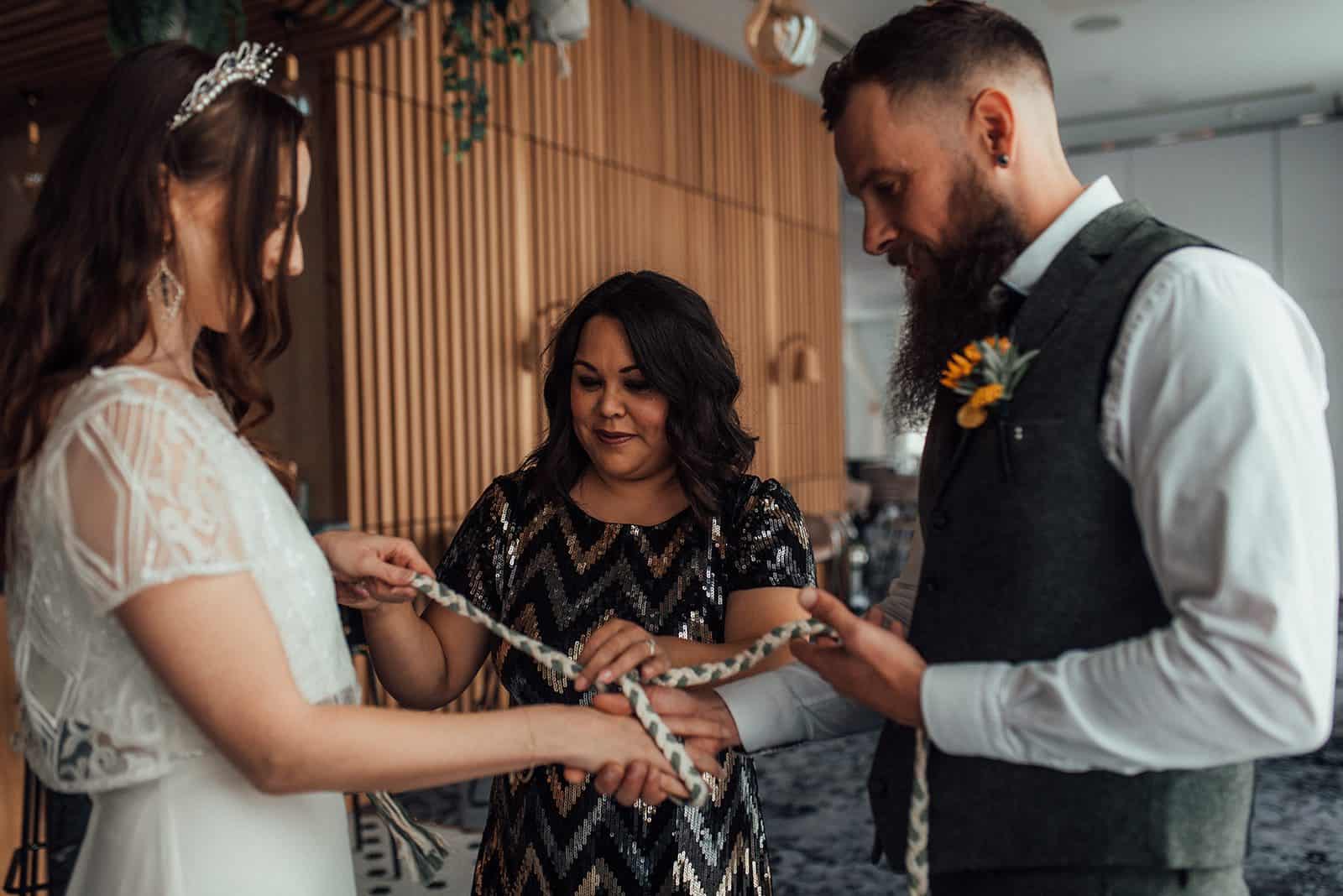
Image Marni V Photography
MEET THE EXPERT
Liz William, a priestess and longtime celebrant. Liz is the author of “Modern Handfasting A Complete Guide to the Magic of Pagan Weddings“. She holds a PhD in the philosophy of science from Cambridge University.
I used this book as my starting point and after it piqued my interest I delved into the world of paganism and pagan weddings. Liz is quoted throughout from her book. I have also reached out to her as it would be wonderful to get some top tips to share with you all.
I highly recommend if you are planning a pagan wedding or want to learn more about handfasting and pagan weddings to buy her book.
Modern Handfasting A Complete Guide to the Magic of Pagan Weddings
More Pagan blogs
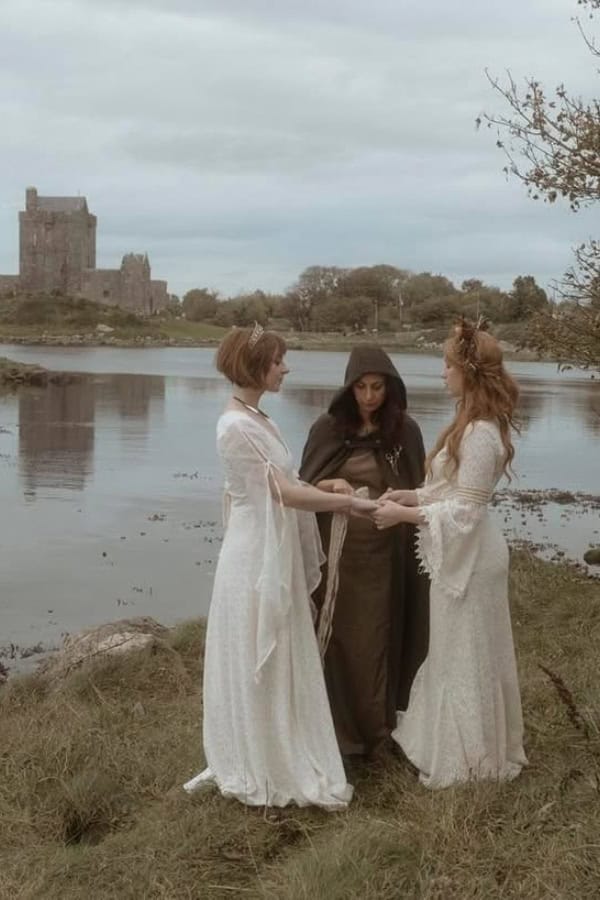
WHAT IS PAGANISM?
So let’s start by explaining what Paganism actually is.
Paganism is a term used to describe a diverse and often loosely defined set of spiritual and religious beliefs.
Pagan is derived from the Latin ‘Paganus’, which was a term used at the end of the Roman Empire to label people who worshipped a religion other than Christianity.
Paganism is typically not associated with the major world religions, such as Christianity, Islam, Judaism, or Buddhism.
Paganism encompasses a wide range of traditions, many of which are rooted in pre-Christian, indigenous, or polytheistic belief systems.
These traditions can vary significantly, but they often share a focus on nature, the cycles of the seasons, and the veneration of multiple deities or spirits.
I enjoyed reading this viewpoint on paganism, it gives insight into pagan beliefs.
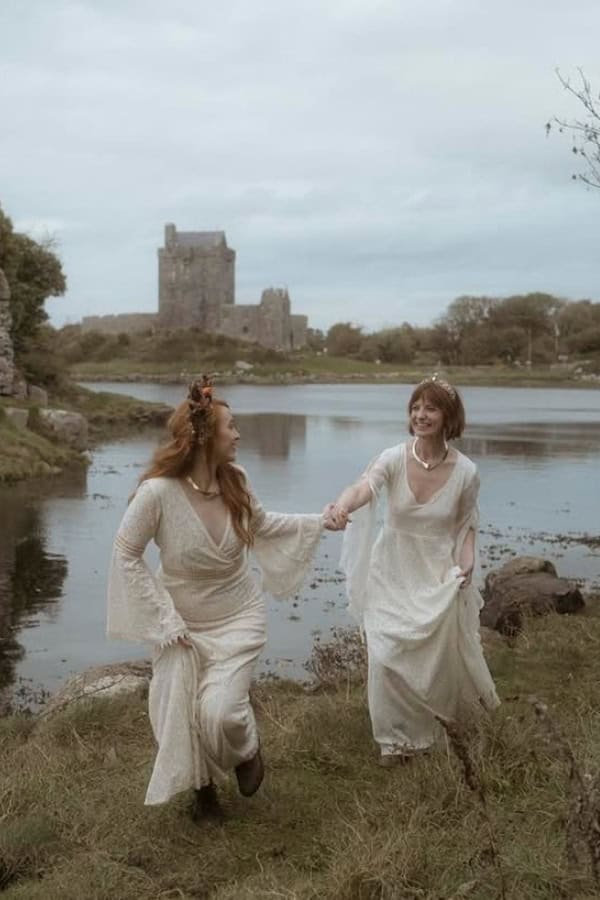
Key characteristics of Paganism include:
- Polytheism: Many Pagans believe in and worship multiple deities or spirits. These deities often represent various aspects of nature, the human experience, or specific cultural elements.
- Nature-centered: Pagan beliefs often emphasize a deep connection to nature and the natural world. Seasonal cycles, the elements, and the Earth itself play important roles in Pagan rituals and practices.
- Rituals and ceremonies: Pagans often engage in various rituals and ceremonies to honour their deities, mark significant life events, and celebrate the changing seasons. These rituals can vary widely among different Pagan traditions.
- Diversity: Paganism is not a monolithic or organized religion. It encompasses a wide array of traditions, including Wicca, Druidry, Heathenry, Hellenism, and many others. Each tradition has its unique beliefs and practices.
- Folklore and mythology: Many Pagan traditions draw on the mythology and folklore of specific cultures, incorporating these stories and legends into their religious practices.
- Personal spirituality: Paganism tends to be individualistic, with practitioners often having a great deal of autonomy in their spiritual beliefs and practices. There is no central religious authority in Paganism.
It’s important to note that the term “Paganism” is a broad and somewhat vague label, and not all Pagans subscribe to the same beliefs or practices.
Some Pagans may identify as witches or follow a magical path, while others may focus more on the cultural or historical aspects of their chosen tradition.
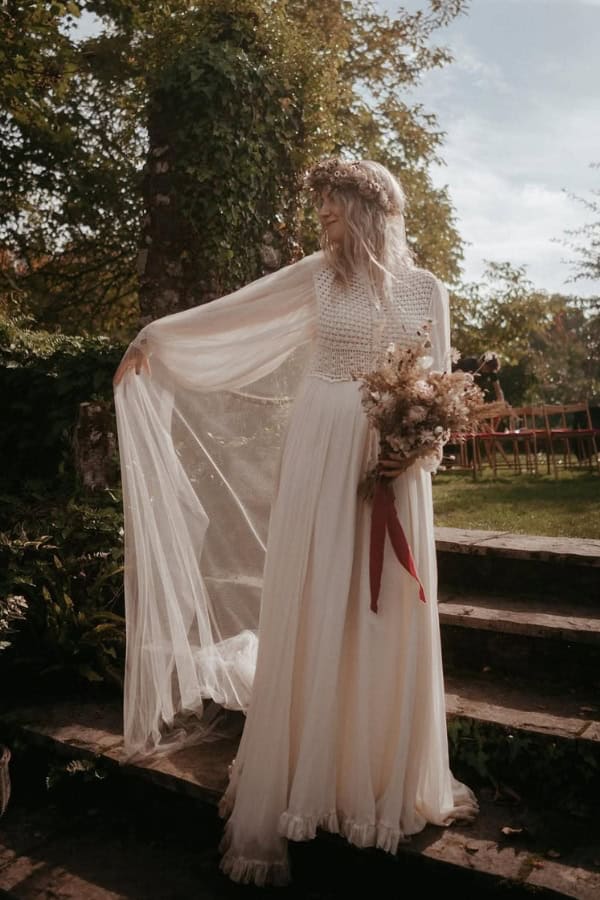
Modern Paganism
According to the Pagan Federation, today, the Pagan tradition is evident in two distinct expressions. In some regions, particularly in Eastern Europe, communities are actively working to recover their ancient sites and rituals, aiming to restore a sense of harmony between humanity and the Earth.
Meanwhile, in Western Europe and European-settled countries abroad, individuals are embarking on personal spiritual journeys, often in small groups, guided by one of the Pagan deities.
In modern Paganism, three of the most prevalent religious tenets include:
- Wicca: Wicca is a spiritual tradition centred around the observation of seasonal changes. A core doctrine of Wicca is encapsulated in the Rede, which advocates the principle “An it harm none, do what thou wilt,” emphasizing harmlessness in one’s actions.
- Asatru: Asatru is an interpretation of Norse mythology, drawing inspiration from the past, including the Viking era. Three of the Nine Noble Virtues in Asatru include qualities such as “courage,” “truth,” and “honour.”
- Druidry: Druidry seeks to reenact traditional Celtic rituals, placing a strong emphasis on poetry and narrative. A common teaching in Druidry is the Celtic triad, which highlights “3 things lovely in a person: tranquillity, wisdom, and kindness.”
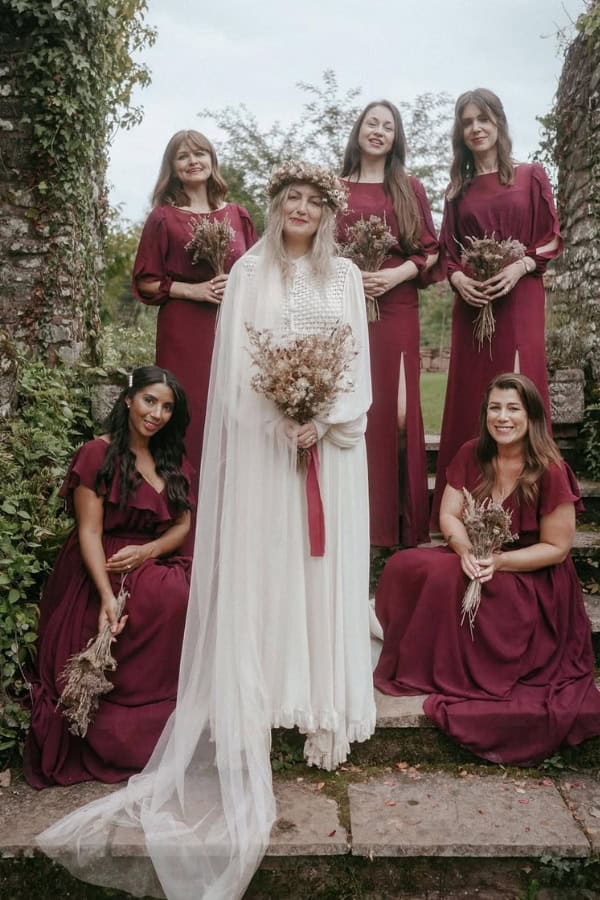
PAGAN WEDDINGS
A Pagan wedding, like Paganism itself, can vary significantly depending on the specific tradition or belief system of the individuals involved.
Pagan weddings are often characterized by a focus on nature, symbolism, and personal spirituality.
Over time, many elements from paganism have become part and parcel of modern non-religious and some religious wedding ceremonies.
PAGAN WEDDING TRADITIONS
The main tradition that Pagans subscribe to is handfasting (tying your hands together as a sign of unity).
They may also add jumping over fires or brooms for good luck and feasting after the ceremony.
The most important part of a pagan wedding is that it must be uniquely created for each couple, instead of following tradition or ritual exactly as it has been done before.
There are many different elements you can add to your pagan wedding ceremony from coloured ribbons on trees for good luck, handfasting, oaths and blessings, to incorporating the elements into your wedding vows.
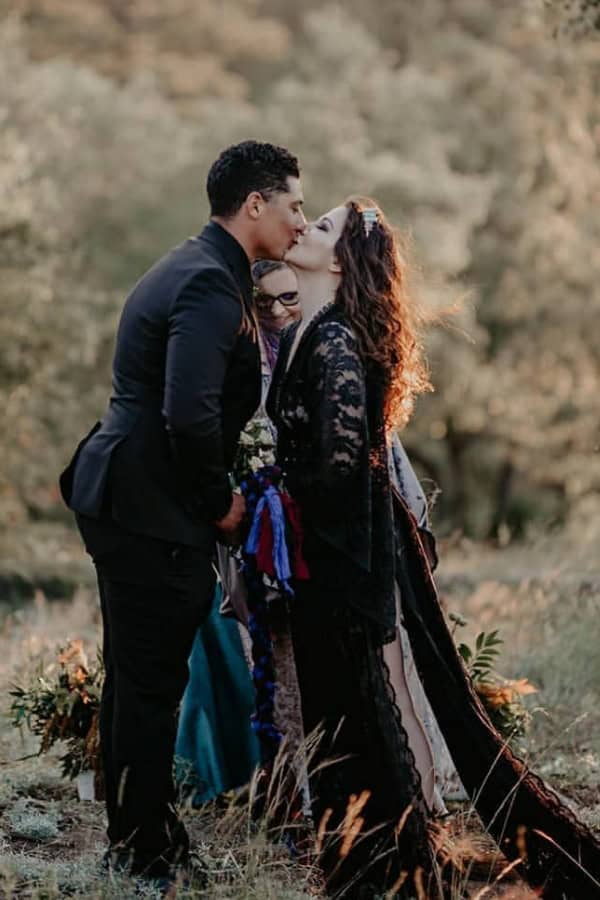
PAGAN WEDDING CEREMONY – HANDFASTING
A pagan wedding ceremony can be a mix of traditional pagan rituals.
The most popular for modern weddings is a handfasting ceremony.
Handfasting is a ritual where two people are bound together as one. It’s an ancient Celtic wedding custom that has been adopted into modern weddings.
It can be adapted to include some of the elements you want for your wedding ceremony.
A handfasting takes place before the actual wedding vows with both parties’ hands being tied together during the ceremony. Tying the knot.
Handfasting is a way to show love and commitment to each other in front of your friends and family, while also showing the world that you are committed.
The word handfasting comes from an Old English term meaning “tying hands” or binding promises.
Each person in the ceremony holds a part of a wrapped cord or ribbon, and when they recite their wedding vows, one end is tied together.
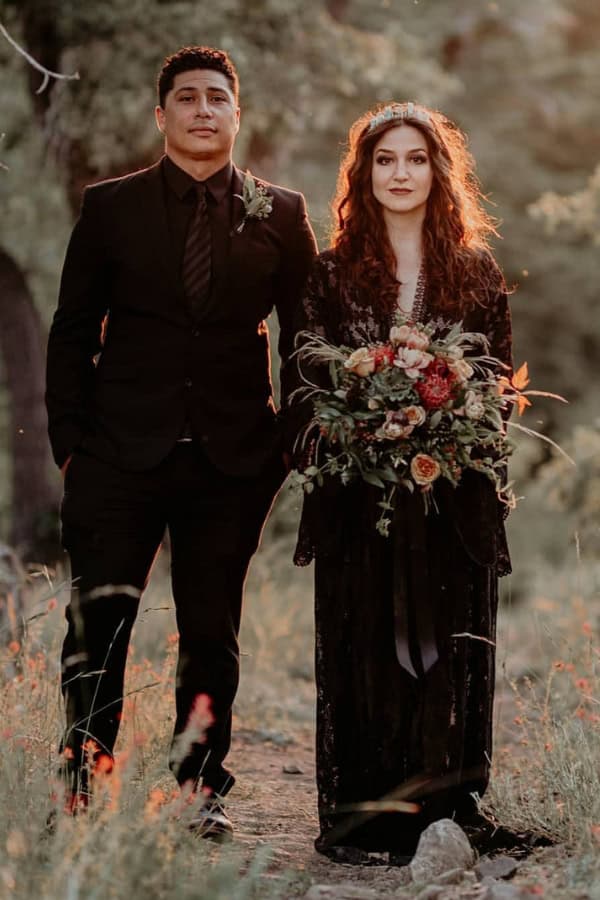
PAGAN WEDDING CEREMONY IDEAS
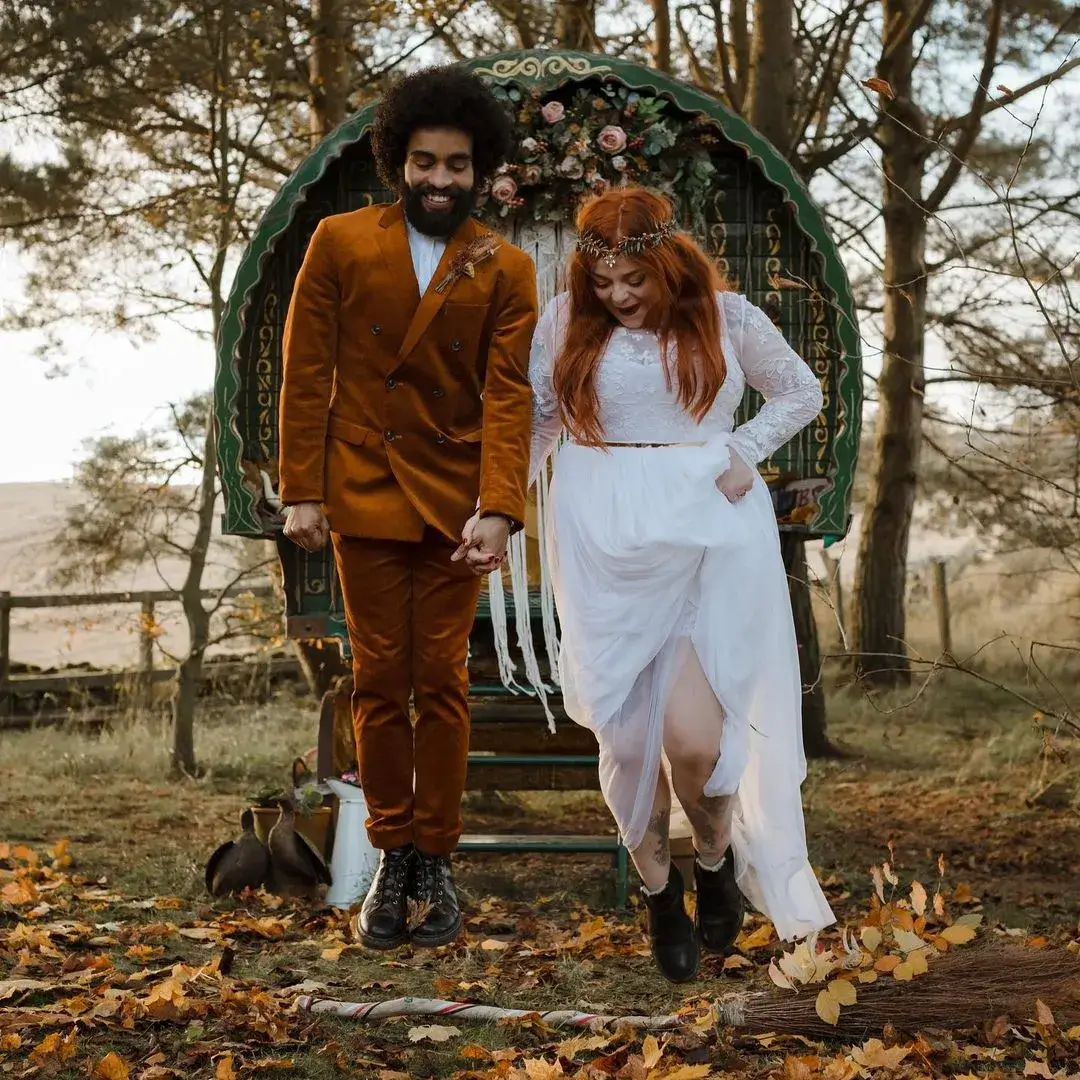
1. JUMPING THE BROOM
Jumping over a broom is an old pagan custom that was once used for good luck in marriage ceremonies. The idea behind it is to sweep away any past negativity from your life before you start fresh with your spouse.
THE FOUR ELEMENTS
Most Pagan wedding ceremonies will include or acknowledge the 4 elements in some way during the ceremony. This adds a sense of balance and harmony to the proceedings. Air, fire, water, and Earth.
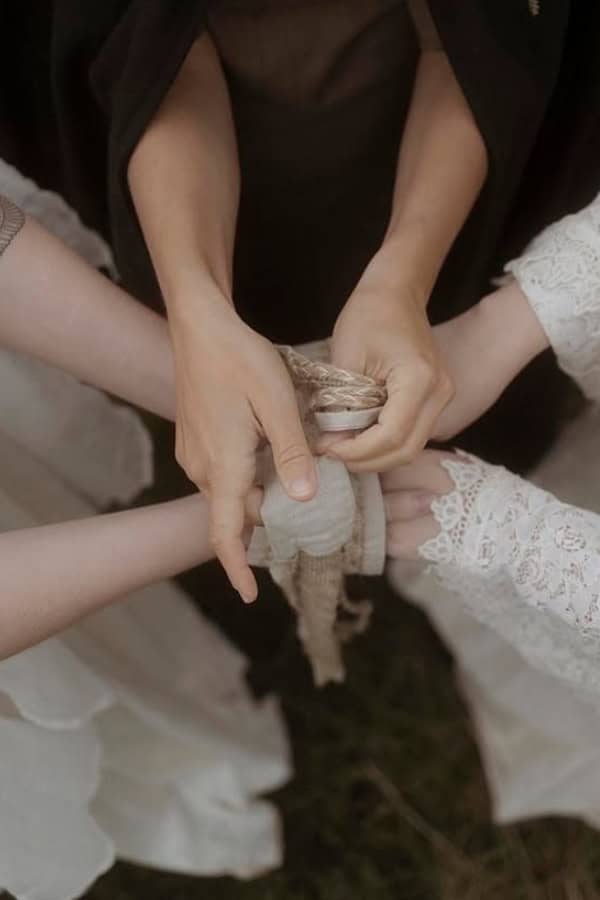
2. TYING THE KNOT
Most Pagans believe that tying the knot symbolizes two souls becoming one. It also represents their combined strength and commitment to each other, which is why most Pagan weddings include some form of handfasting or binding ritual.
The knotting ceremony consists of the couple being bound together, usually with a ribbon or cord. During this process, the couple recites their vows and exchanges rings to symbolize that they are now one.
There are many different knots and rituals which we talk about in detail in our handfasting blog.
3. A SACRED CIRCLE
Guests gather in a circle around the couple and the officiant, usually in an outdoor ceremony. The circle is typically marked with natural elements like flowers, stones, or salt and represents the eternal cycle of life, love, and nature.
It is a space where the couple, officiant, and sometimes guests gather to invoke blessings from the elements, deities, or spirits.
The act of creating and entering the circle signifies leaving behind the mundane and stepping into a sacred realm. It honors the couple’s union in harmony with nature and spiritual forces.
4. BLESSING THE SPACE
The officiant, generally a priest, priestess, or revered friend, will light incense or sage and invite the gods, goddesses, and spirits to gather as a spiritual circle around the physical circle.
5. GODS, GODDESSES, SPIRITS, AND ANCESTORS
Many diverse gods, goddesses, and spirits are worshipped by Pagans. The elements are also represented in a variety of ways. The officiant will call these beings or powers to join the event at the start of the ceremony before any sacred readings or vows are said.
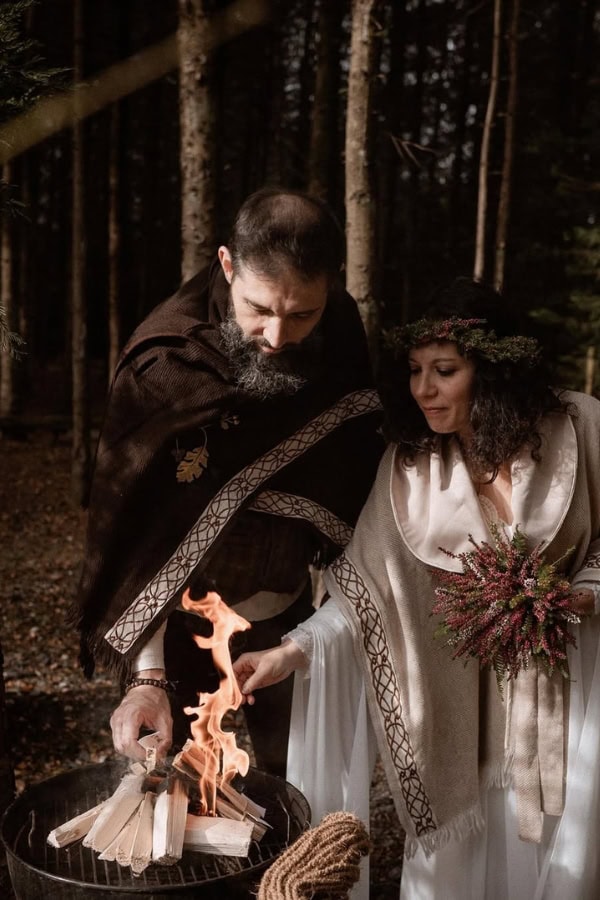
6. OFFERINGS AND ALTARS
Near the officiant, an altar may be prepared with significant items such as candles, incense, or blessed wine. The couple can use these items in a unity ritual, or they may offer them to the gods. If you haven’t been asked to, keep your hands off them.
7. POEMS, SONGS, THEATRICAL PERFORMANCES, AND STORIES
The officiant and/or guests provide joyful readings, these can last much longer (and include more interaction with guests) than those at nonreligious or traditional weddings.
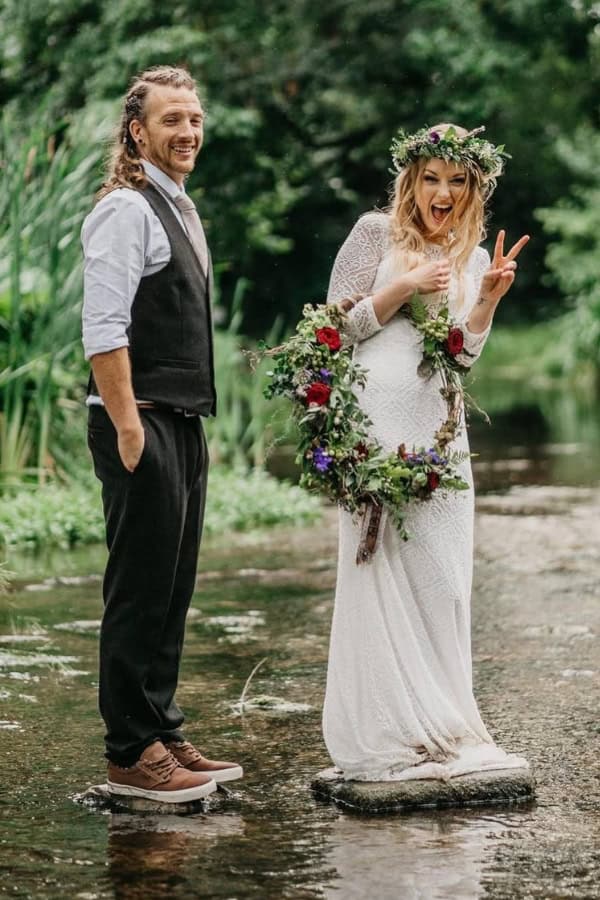
More Pagan blogs
IS A PAGAN WEDDING LEGAL?
In some countries yes. It depends on your country or state’s rules and regulations.
In some regions and countries, you must also include a ‘legal marriage’, like a registrar before or after. You may have to have two separate ceremonies all together depending on where you plan to marry.
I will share some guidelines below but you are best speaking to your local council and your celebrant as they will be most knowledgeable about the laws in your area.
Uk Pagan Wedding
For most, the answer in the UK is no, especially in England. In Scotland and Northern Ireland, you can legally be married by a humanist celebrant. This can not include any religious content.
In Scotland you can legally have a pagan ceremony, you can find a list of pagan celebrants on the Scottish pagan federation.
To legally marry in England with a Celebrant ceremony, you must register your intent to marry and schedule an appointment at the registry office for the legal paperwork.
This appointment involves signing the marriage license and making contractual statements in the presence of two chosen witnesses. Exchanging rings and vows is not a legal requirement and can be saved for your Celebrant-led wedding ceremony.
There are also other European countries you can legally have a pagan wedding ceremony. In Ireland pagan weddings are legal, head to our Irish wedding tradition blog for more information.
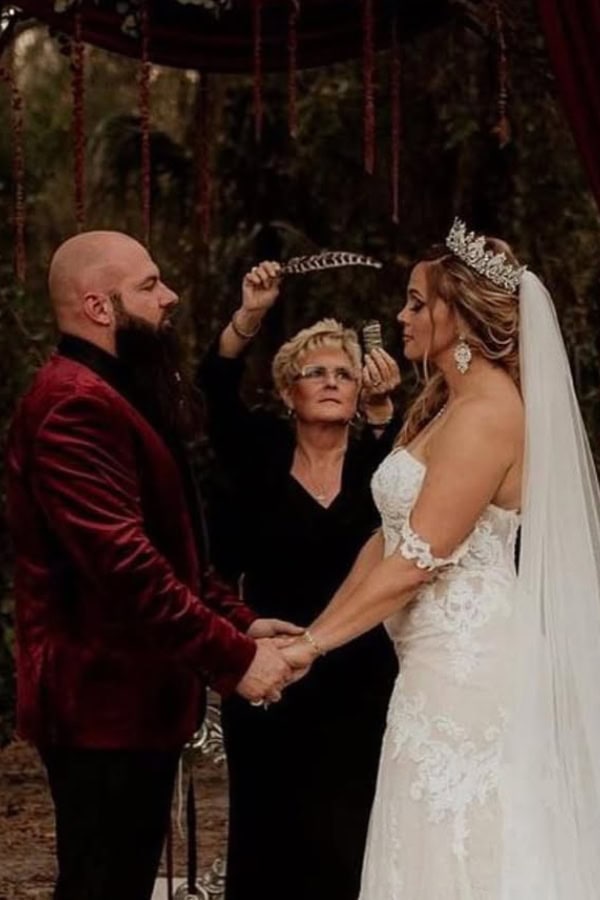
Us pagan weddings
Yes, pagan weddings are legally binding in all states of America. The celebrant needs to be registered by the individual state, according to Liz Williams.
Pagan weddings in the United States, like weddings of many other religious and spiritual traditions, need to comply with the marriage laws of the state in which the ceremony takes place.
Marriage laws vary from state to state, but generally, they require a marriage license issued by the appropriate government authority.
It’s essential for couples planning a Pagan wedding to check the specific marriage laws and requirements in their state and make sure they comply with them to ensure the legal recognition of their marriage.
Pagan weddings around the world
I suggest grabbing Liz’s book for a more in-depth overview of each country. I really can’t go into the rules of each country.
Below is a table that I will keep updating as I gather more knowledge. Please do comment below with any countries I can add or may have got wrong.
| Country | Legal | Extra Information |
|---|---|---|
| England | No | Easy to do the legal part and then have a pagan celebrant ceremony |
| Ireland | yes | |
| Scotland | Yes | They need to be registered with the Scotish pagan federation |
| America | Yes | Each state varies so check with your state |
| Austrialia | Yes | as long as carried out by a licensed celebrant |
| Canada | Yes/No | Different states have different rules |
| New Zeeland | Yes | Along with a marriage licence |
| Denmark | Yes | This is only as long as all other legal elements are followed |
| Sweden | Yes | This is only as long as all other legal elements are followed |
| Norway | Yes | This is only as long as all other legal elements are followed |
| Finland | Yes | This is only as long as all other legal elements are followed |
WHO CAN PERFORM A PAGAN WEDDING?
Anyone can perform a pagan wedding ceremony. It could be your friend, someone you know. If the bride and groom are already practicing pagans themselves they may choose to do it on their own with just their families present.
The best person to officiate is someone who knows you both well, has known you for at least six months beforehand and can perform a ceremony that both you and your future spouse will enjoy.
You can opt to have a higher priest or priestess perform your ceremony if you are a practising pagan. Or most celebrants will offer handfasting ceremonies as an option.
Of course, who you use will depend on whether you are having them perform a legal ceremony. This would usually need to be a Registered celebrant but not in every country.
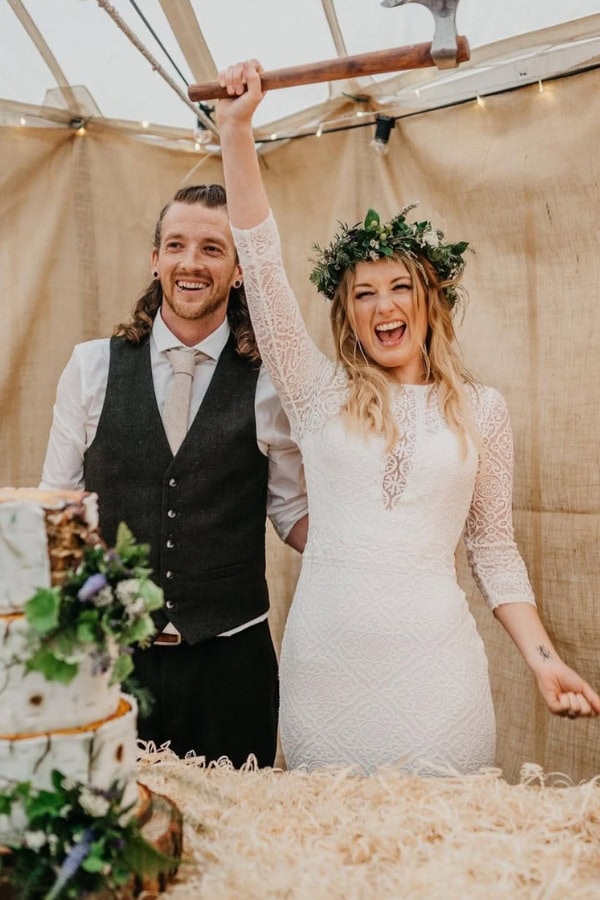
PAGAN WEDDING VOW IDEAS
A Pagan wedding is an opportunity to make your vows special and unique. There are many different pagan vow options but the most important thing is to make it personal and unique to you as a couple.
Work with your chosen officiant and come up with vows that tell a story about you as a couple. Here are some ideas for vows to one another.
Head to our handfasting vow guide for lots of advice on script and vow creation.
1. SHORT AND SIMPLE VOW
May you be filled with joy for the rest of your days. May the road rise to meet you, and may the wind be at your back. May sunbeams warmly fall upon your home, and may a friend’s hand always be nearby. Green is the grass on which you walk; blue is the heavens above you; innocence is pure.
2. GOOD FOR A HANDFASTING CEREMONY
These are the hands of your closest companion, the ones that are young and strong and full of affection for you, which are clasping yours on your wedding day as you vow to love each other today, tomorrow, and always. These are the hands that will work alongside yours as you create your future together. These are the hands that will passionately adore
These are the hands that will wipe away your tears time and time again, tears of sorrow and joy. These are the hands that will hold your children carefully, hands that will bind your family together.
These are the hands that will provide you strength when you need it, offer support and encouragement as you pursue your ambitions, and soothe you during challenging times. Furthermore, these are the hands that, even though bent and wrinkled, will still be reaching for yours, still conveying the same unspoken affection with a light touch.
3. VOWS INCLUDING COLOUR CORDS
Do you think that you could trust each other with your hearts and yourselves, and make time to be together?
The dark blue cord, representing Water, is draped over the couple’s hands to symbolize that your love may flow and fill you to your depths. [The dark blue rope is draped over the pair’s wrists.]
Will you both try to alleviate one another’s anguish and suffering, sharing joy and pleasure?
The second binding is made of green, which symbolizes Earth and indicates that your love may be wise and nurturing, as well as happy. [The couple’s hands are draped in a green cord.]
Will you use your daily actions and encouraging words to keep your relationship alive?
The third strap is made of red, signifying Fire, to symbolize the brightness and passion of your love. [The red cord is draped over the hands of the couple.]
Will you both assist one another in developing your spirit and intellect?
The fourth binding is completed with a light blue cord, symbolizing Air, which may represent your love as limitless as the sky and filled with life. The light blue cord is draped over the hands of the couple. All four cords are linked together.)
You’ve just been bound together, your two lives linked by love and trust into one.
More blogs you will love!
- 30 Unique Wedding Ideas Trending in 2026
- Who Pays for What Now? Money Scripts for Modern Families
- Seating Plans When Your Family Isn’t “Traditional”
- 30 Unique Wedding Venues in Manchester for Modern Couples
- Forever Starts Here: Modern Date Tattoo Ideas for Wedding Memories
- Alternative Guest Book Ideas for a Unique Wedding
- Fun & Interactive Save the Date Ideas to Wow Your Guests
- Unique Save the Date Ideas Your Guests Will Actually love
- Nonreligious Wedding Reading Ideas: Celebrate Love Your Way



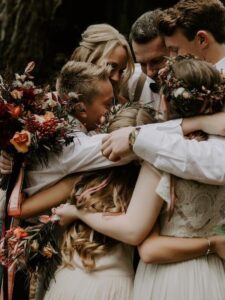
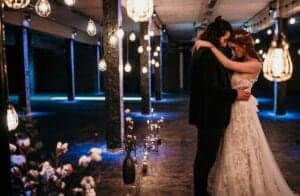
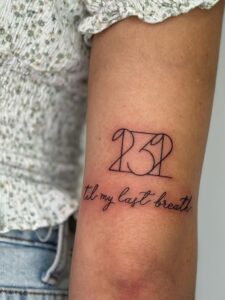



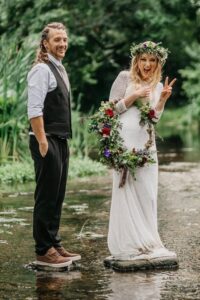

many african americans have stated that they feel it’s inappropriate for non black people to “jump the broom” so please do research and please perform at your own discretion <3
Hi Leigh, thank you so much for your comment. I do believe in American culture yes it is linked to African Americans and slavery. If you do research though you will find that there is scholarly evidence and lots of cultural tales that show it did in fact originate in Britain, mainly wales, with pre-Christian and pagan rituals. This is a great read and has links to research further. https://www.oprahdaily.com/life/relationships-love/a35992704/jumping-the-broom-wedding-tradition-history-origins/ Thanks, Zoey
This is a Pagan ritual I don’t understand why race always has to be brought up into things. Paganism has been around a very long time. You do your research as well before telling anyone they can’t do something at their own ceremony.
You do your research. Celtic cultures were jumping the broom (or besom) long before African American culture picked it up. Try again.
A lot of rituals have various roots and are performed by variety of cultures. There’s a tribe in Africa which performs voodoo celebrations and rituals, and they jump over the fire during some of them. The same ritua was conducted by pre-christian Slavs. Both have different origins. Brooms are also associated with various folklores around the world – Asia, Europe, Africa… Nobody can own a culture, and a lot of rituals, that might seem the same, have various ethnical origins and meanings.
Honestly, I heard about “Jumping the broomstick” on a video and it sparked my curiosity and interest. I dont practice Paganism or Wiccan, but my mother was one. My belief structure is also based around Paganism, so I believe in multiple Deities instead of Gods.
I am now planning on Handfasting, and doing an Offering at my ceremony, and maybe some others. But thank you for this article, helped me open a door I didnt know I needed!!!
Congrats on your upcoming wedding, sounds like an amazing ceremony! Glad the blog could help you. It is such an interesting subject with so much history.
It IS actually legal to get handfasted legally at one place in the UK in the Goddess Temple in Glastonbury. My wife and I were married there in 2017.